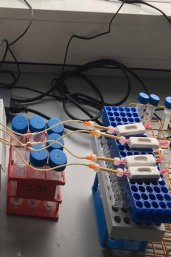How PhD candidate Paul Jochems is valorising his research
Our intestines are constantly in contact with the outside world. Everything we ingest passes by their lining, which it where nutritional value is truly defined. Which foods are readily taken up and which are harder to digest? Food scientists need specific answers to these questions to develop sustainable and alternative food sources for our growing population. “You can ingest new types of food and measure input and output” says Paul Jochems, PhD student at Utrecht University, “But that does not tell you what happens at the molecular level. ” To study the exact mechanisms of the human gut, Jochems developed an intestinal model that proved reliable in studying the safety and biological efficacy of various proteins. His PhD is nearly finished, but the model he developed will have a second life outside academia.
Food security is one of the major fields of research at Utrecht University. In the future food hub, research converges to contribute to the transition of the food chain for a sustainable world. Investigating the biological efficacy of new types of food is part of that research. It is a common practice in industry, as well as an active area of academic study. The PhD research of Paul Jochems reflects both these interests. On the one hand he developed an intestinal model as part of a larger ‘sustainable future proteins’ consortium with various industrial partners, while on the other his improved model is an academic exercise. “That is, until the food industry is interested in using it,” he laughs. As Paul writes the final parts of his thesis, he is already thinking of potential customers for his model.
My model is basically a re-created piece of gut lining, along which food can travel while the biological effect of nutrients is studied. That's something I could explain to my mother.

Although his research is at the molecular level, Jochems was never interested in purely fundamental research. “I like the kind of research I can explain to my mother,” he says. The gut model he developed can be explained in layman’s terms as: ‘a re-created piece of gut lining, along which food can travel while the biological effect of nutrients is studied’. This ‘gut on a chip’ fits in a small plastic chamber and has already successfully tested 18 different protein sources, including alternative food sources sent by industrial partners, such as insects and potato parts that are commonly lost in production. These practical industrial applications converge with more academic questions: Jochems also applied for funding to do fundamental research in collaboration with plant researchers. With the Future Food Seed grant he hopes to use his model to screen different genetic strains of lettuce, and establish their biological effectivity.
A unique model

The ‘gut on a chip’ model Jochems has designed is unique in its level of realism. While the present industry standard is to use Caco-2 cells which differentiate into enterocytes (the most common cell type in the small intestines) on a flat membrane by which test substances are passed, such models lack the cell diversity of cell types found in the intestines as well as the physiological structure of the intestinal lining. “Our model has more a realistic, tube like structure, on which we introduce ‘shear stress’ to simulate food passing by the cells,” says Jochems. “This results in a more realistic simulated gut which has a higher predictive value”. The ‘villi’ found in our intestines increase the surface area by which nutrients can interact and pass. “Our model incorporates these structures, resulting in a much larger surface area than conventional tests,” explains Jochems. While this may be academically sufficient, Jochems now has a challenge to convince industry. “What they look for is improved predictability and test validity, I believe that my model can offer this.” It takes about 30 days to fully build a simulated gut, using Caco-2 cells on extracellular matrix coated hollow fiber membranes to model a natural environment resulting in differentiation into different cell types analogous to our own bodies. The test has limited human handling, to minimise the experimenter effect. With its cells on the outside for easy visualization and monitoring, it has great potential. It performs exceptionally well on control proteins as well, giving it a great market potential.
Market value
Based on his published work a potential first customer approached Jochems about 6 months ago. “That got me thinking,” says Jochems. “Now my model is used to screen something outside the scope of my own project.” This was always potentially a spin-off, but while he writes up the last part of his PhD thesis, the valorisation question becomes real. “Entrepreneurship was always in the back of my mind,” he says. With his PhD contract extended to focus on valorisation, he now has time to develop his entrepreneurial side. “It all started rolling after I spoke with Stephen Gray and Friso Smit from Utrecht Science Park in January" says Jochems. We spent a lot of time discussing the possibilities for startups in the Utrecht Region and Stephen introduced me to the ROM region Utrecht. "I had lots of questions: What is valorisation, is it something I want, what does the business landscape look like at Utrecht Science park and what do I say yes to when I do this? Stephen and Friso were instrumental in getting me on the 'straight' path." Another key person is Paul's PhD supervisor Roos Masereeuw, who saw his potential and organised the first extension of his PhD contract. “I am very grateful to Roos for opening up this opportunity. I participated in two calls for funding: The NWO venture challenge and the UU valorisation grant. I am happy to say both were awarded and we’re moving forward.”

Valorisation at UU
The UU valorisation grant allows researchers to spend a year on valorisation of their research. “I received funding for 2 postdoc researchers for this year, one of them being myself.” Jochems is now looking for someone with an engineering background to help further develop the assay. “Having secured this funding and an initial postdoc position is a big step. I felt a lot of support from UU, but also found that was no set route for valorisation. It takes a certain kind of person to find their way in this landscape,” he recalls. The corporate aspects of ‘selling your research’ are not part of a traditional PhD skill set. “No matter what happens next, now I am learning to see value in research (other than academic value).” The whole trajectory is a journey. “Chatting with plenty of people is definitely helpful. I don’t think all PhDs want this, or have this ambition.” There is support from all sides: “My PhD supervisor suggested an MBA course, while UtrechtInc. approached me with one of their business courses. There are plenty of opportunities to choose from. At the risk of sounding overly bold: If you think you want this and you can do it, take it.”
Scientific value vs market value
During a PhD trajectory, the standard path usually leads to open science, publishing your research and thereby gaining academic traction and relevance. But what if your research has marketable value? “Publishing can mean killing business opportunities,” says Jochems. And while valorisation is part of the university’s policy, this can be at odds with the core values of open science and open data. “Many students see obligatory publications as a hurdle to be taken towards the next rung on the academic ladder,” says Jochems, while protecting your data and delaying publication are also real options. “For instance, you can publish your work in private circles, defend your thesis privately and apply for a patent before publishing to the entire academic world.” While there is precedent for this, it is often difficult to find, and challenging to organise. “It starts with a good supervisor who sees and shares such opportunities.” Paul Jochems already submitted his research to a journal. Not only the physical gut model itself, but also the multi-factor analysis method are potentially patentable. His model and methods have obvious advantages, but getting the model to the market needs a good story. When asked, Paul provided his elevator pitch:
"Over 50 years ago the reduction, refinement and replacement (3R’s) of animal experimentation framework was developed. In 2017, the Dutch government communicated the intent to phase out animal experimentation altogether, with the first animal-test free year occurring in 2025. To achieve this goal, current practice (Caco-2 cell on Transwell™ inserts), based on a model developed in the 90’s, is simply not good enough and drawbacks have to be improved. We offer a state-of-the-art novel small intestinal in vitro model, the bioengineered intestinal tubule (BIT). The BIT resolves acknowledged drawbacks of the Transwell™ model, by offering differentiated epithelial cell populations and physiological micro-architecture. We offer a professional service, where perform compound testing focusing on intestinal biological characteristics e.g. the epithelial barrier or absorption. After biological data is acquired we can combining all available data evaluating compounds to e.g. reference/competitor compounds."
Footnote
Would you like your own story to get noticed? Let us know at utrechtlifesciences@uu.nl and maybe we'll interview you next!

